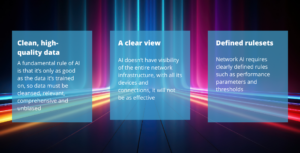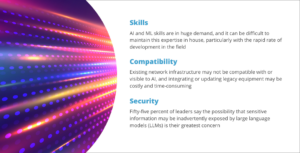Few technologies have generated as much hype as artificial intelligence (AI). From customer service to HR to software development, it has the potential to change the way all industries operate at a fundamental level.
One area where AI could have a dramatic impact is in the increasingly demanding space of network management. As sprawling organizational networks become more complex, disparate, and costly, how can network teams harness AI to build the responsive, high-performance infrastructure that their organizations need?
Networks Are Increasingly Complex and Under Growing Strain
Enterprise network teams have a lot of plates to keep spinning.
Cloud services, a proliferation of connected devices, globally disparate workforces, and hybrid working all have led to complex network topologies. Nearly 56% of organizations have more than 500 network devices, and, astonishingly, 10% have more than 5,000. This is making networks increasingly difficult, expensive, and time-consuming to manage.
At the same time, more latency-sensitive applications and services are in use, exponential volumes of data are being generated and consumed, and expectations of the network’s ability to enable business agility are growing.
This increase in use and expectations is putting strain on the network at a time when the impact of network downtime on businesses is rising; staggeringly, Gartner estimates the cost of unplanned downtime to be around $5,600 per minute.
Together, these pressures are driving significant interest in AI’s potential to help network professionals improve the performance, capacity, and efficiency of their networks.
What Is AI, and Why Is It Relevant?
AI aims to simulate human intelligence using computers. For enterprise networking, one of the most relevant areas of AI is machine learning (ML), which uses algorithms to imitate the way that humans learn and adapt, without explicit programming.
ML trains itself to become more accurate using massive datasets. It has the capacity to analyze huge quantities of data and produce recommendations for action, and even make decisions without human intervention.
This capacity for handling large amounts of data is where AI’s capabilities are generating interest, and it’s why 96% of IT decision-makers have already implemented AI in their network operations, or plan to do so shortly.
Unlike Humans, AI Can Handle the Deluge of Network Data
Enterprise networks generate a tidal wave of usage and performance data, coming from a variety of routers, ports, servers, applications, and connected devices. Because there is too much data for human resources to comprehensively monitor, this potentially valuable information often remains unused.
Unlike humans, AI has the capability to analyze and interpret this data to generate a detailed picture of what’s happening across the network in real time. AI provides network teams with the comprehensive, granular view of the network that’s so important for decision-making and for optimizing network performance.
AI Has a Growing Role in Network Automation and Troubleshooting
AI is already capable of intelligently automating parts of network management, such as basic administration, troubleshooting and anomaly management.
Automating routine network administration helps to eliminate user error. Since manual administrative errors (such as bad configuration changes) cause 27% of all network problems, AI can significantly reduce these kinds of issues.
AI can monitor network health and identify anomalies faster than humans, and can quickly and precisely pick out root causes from all the available logs, metrics, and alerts. Intelligent automation can even help with basic remediation.
For example, if one area of the network experiences congestion, intelligent automation could re-route traffic via less-affected routes. If the cause is identified as a new device that’s been badly configured, AI may be able to fix it automatically. If not, automated systems can send alerts to network administrators to trigger human intervention.
Automation relieves the network team from mundane tasks so they can work on more skilled jobs, and reduces the operational costs of managing complex multi-domain networks. It also allows network data to be harnessed instantly to improve network health, boost uptime and tackle issues before they affect users and organizational productivity.
Healthcare provider Renown Health, for example, uses AI-powered automation to manage a homogenous network made up of 1,400 access points and 48,000 ports with a team of just three people. AI capabilities have dramatically reduced the time needed to manage its network, and have helped it move from reactive to proactive network management. It’s now possible, for example, for a single IT team member to orchestrate the setup of 20 locations in one night, a task which previously took a week or more.
Intelligent Networks Boost Performance, Planning and Utilization
AI is already helping with managing network traffic more effectively. Smart switches, for example, can identify latency-sensitive traffic, such as video and IP voice, and automatically assign a higher level of service to make sure it’s prioritized appropriately.
AI also can make capacity planning more accurate, keeping costs to a minimum while still meeting the bandwidth and performance needs of the business.
It does this by gathering and analyzing network data to provide clearer insight into the trends and patterns of network usage, which allows ML to make predictions about future utilization. Intelligent networks use this information on current and predicted utilization to dynamically scale capacity and reroute traffic.
AI Helps Network Teams Prioritize Alerts and Streamline Remediation
When network alerts occur (to signify issues such as performance falling below a certain threshold, for example) AI can help to streamline the notification and communication process.
AI is increasingly effective at correlating data from different sources to proactively identify anomalies and alert the network team, even if notification thresholds haven’t been reached or are not defined. This helps to solve network issues before they escalate.
Many network teams are swamped with notifications, and it can be hard to distinguish which ones need attention. AI is already helping network teams prioritize notifications depending on the severity and potential impact of issues, and even to suggest the appropriate action to take.
Some vendors also are offering integration with existing messaging platforms using natural language interfaces, making it easier for users to understand and explore network alerts.
The Rise of Autonomous, Self-Healing Networks
As AI becomes even more sophisticated, it will require less human intervention and become more autonomous, driving down management costs, and improving network performance and uptime even more.
ML’s ability to learn from historical network data to predict future problems will allow it to autonomously tackle issues and put preventative measures in place before they cause disruption to the business. Given that 31% of all IT service problems are reactive, and are reported by end users before the network team is aware, this will have a significant impact on business productivity.
In time, we may see fully self-healing networks with predictive maintenance and automated, intelligent remediation (such as identifying and automatically implementing configuration changes that improve performance or maximize utilization) without the need for human intervention.
We’re also likely to see more and more zero-touch, intelligent ‘plug and play’ network devices that automatically connect, configure and update themselves, removing the need for complex manual setup.
AI needs to undergo significant development before this level of network autonomy becomes a reality. The valuable, real-world use cases we’re already seeing are highly promising, however, and it’s likely that AI will take a starring role in the enterprise networks of the future.
What Foundations Need to Be In Place for AI to Succeed?
Although AI has enormous potential, there are some fundamental requirements that are needed for it to deliver the full benefits:

What Are the Barriers to Enterprise Adoption of AI?

